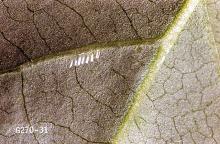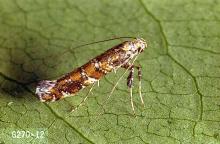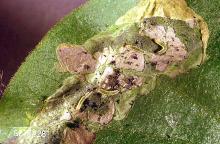Gracillaria syringella
Pest description and damage The adult insect is a golden yellow moth about 0.5 inch in length. The larvae are small, white to pale yellow or greenish caterpillars, 0.125 to 0.25 inch in length. The larvae mine leaves during the early part of their development. During later stages of their development, they are also responsible for rolling leaves and skeletonizing them. Privet (Ligustrum), Deutzia, Euonymus, mountain ash (Sorbus), and ash (Fraxinus) are attacked. Occasionally, lilac leafminer builds to damaging populations but typically, only a few scattered leaves are infested.
Biology and life history Lilac leafminer overwinter as pupae in rolled leaves, or possibly as larvae in dropped leaves. Adult moths emerge with new growth and lay eggs along the veins on the underside of leaves. The larvae hatch and commence mining the leaves forming blotches on the leaf surface. When the larvae emerge from inside the leaf, they roll the leaf over their bodies with silk and continue feeding. Later, they select an undamaged leaf, roll it up, and pupate in it. The adult moth emerges about a week later. There may be several generations per year.
Pest monitoring As new growth comes out in spring, watch for the first small brown mines. Note that the presence of multiple mines in spring could be the harbinger of a heavier leafminer infestation in midsummer and worse in fall.
Management-cultural control The larvae in the mines may be squashed by pinching them while they are still in the leaf mines.
Management-biological
Often the mined leaf harbors a parasitoid feeding on the lilac leafminer larvae and no moths will emerge. There is conflicting information on the wisdom of raking up leaves in fall. While it may remove pupating lilac leafminers, it may also remove parasitoids.
Management-chemical control
See Table 3 in:
Chemical Control of Landscape Pests
For more information
See "Leafminer" in:




